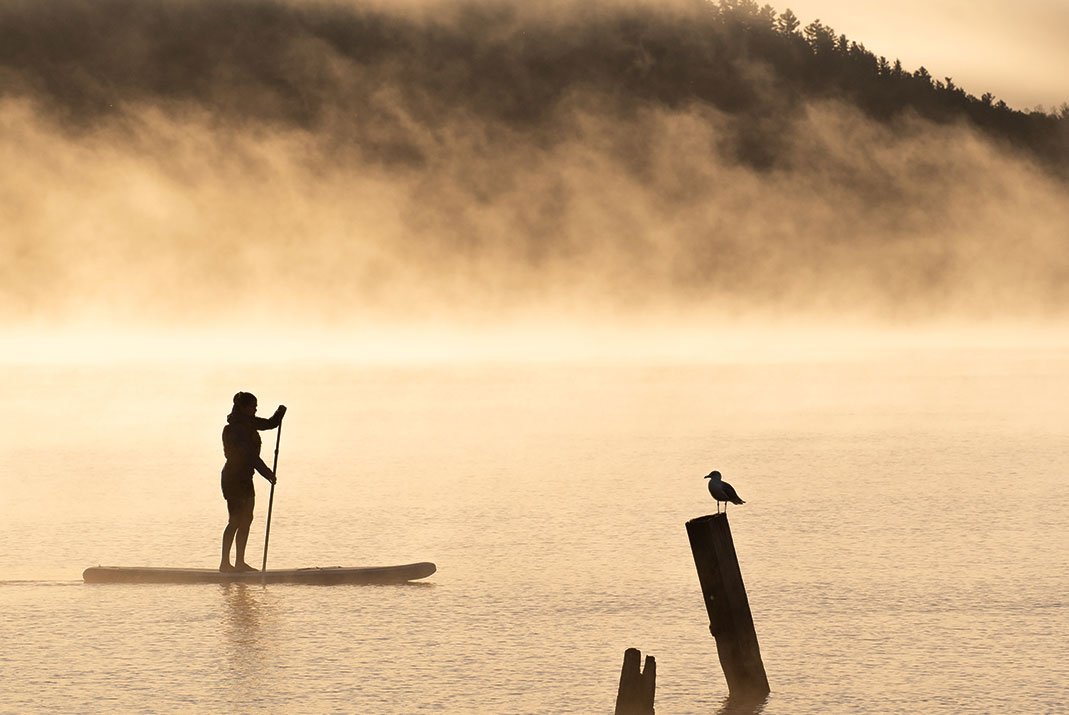Step Aside, Laird. SUP Is Your Parents’ Sport Now
Paddleboarding’s explosive growth has been followed by a decade-long identify crisis, pundits say. | Feature photo: Alija Bos
Step Aside, Laird. SUP Is Your Parents’ Sport Now
Written by Jack Haworth
If you’ve noticed an influx of rookie standup paddlers this past year, you’re not alone. A sport initially dominated by niche categories like racing, downwinding, surfing and whitewater, standup paddling has trended decidedly toward casual participants.
At the Confluence paddle shop in Denver, Colorado, owner Jon Kahn says his decision to increase his standup paddle inventory for 2020 felt like a gamble at first. But after Covid-19 accelerated the emerging trend of more recreational paddlers buying boards, Kahn sold out by early July and logged record SUP sales.
“Definitely the bulk of the market is more casual versus higher performance,” said Kahn. “The whitewater SUP niche is still growing, but it’s like how whitewater kayaking is to kayaking in general.”
Paddleboarding’s explosive growth has been followed by a decade-long identify crisis, pundits say. | Photo: Alija Bos
The explosive growth followed a decade-long identity crisis in SUP. While the niche categories got the attention and drove growth among core users, the bulk of the potential market has always been casual paddlers. Stuck between rentals and racers, the industry struggled to convince people that standup paddling was more than just a vacation activity—or a sport reserved for the Laird Hamiltons and Kai Lennys of the world.
According to the Outdoor Industry Association’s participation data, prior to the pandemic, America’s 3.5 million standup paddlers spent an average of just 6.3 days per year out on their boards, with 26 percent going out seven to 10 times annually. Almost half of standup paddlers own their boards, and of the 53 percent who do not own boards, 42 percent rent them and 26 percent borrow them from someone.
The pandemic only further tipped the scale in favor of casual paddlers. With millions of people looking for an excuse to get outdoors, recreational standup paddleboards became the hottest ticket in town.
“It brought a lot of people into the paddling scene who used to only paddle on vacation, but realized they could paddle all year round,” said Eric Disque, owner of Disco’s Paddle Surf in San Diego. “The light just turned on for people that SUP is a great family activity.”
Disque tripled his sales revenue in 2020 and could have sold more were it not for a production backlog creating a crippling supply shortage. The tidal wave of recreational paddlers was not limited to California. Landlocked and coastal retailers alike reported similar spikes in casual paddlers.
“THE VAST MAJORITY OF FOLKS JUST WANT TO PADDLE AROUND THE LAKE.” — BRIAN VINCENT, APPOMATTOX RIVER COMPANY
“River SUP surfing and coastal SUP surfing is fun and aspirational, but the vast majority of folks just want to paddle around the lake,” said Brian Vincent, General Manager of the Appomattox River Company in Virginia. “We’ve seen an uptick in that and have been doing really well with inflatable SUPs this year.”
The growing popularity of price point inflatable SUPs is no surprise. Vincent noted with younger generations increasingly living in smaller spaces and driving smaller cars, the ability to store an iSUP in a closet or transport one in the trunk of a car is appealing. Not to mention, most iSUPs come with everything needed to get on the water—board, paddle, fin, leash, backpack and pump—at a reasonable price.
Kahn said 90 percent of his SUP sales in Denver are inflatables, with many of those customers being newcomers to paddlesports.
“I DEFINITELY SEE IT GROWING PADDLESPORTS OVERALL BY INTRODUCING NEW PARTICIPANTS WHO MAYBE WOULDN’T HAVE THOUGHT ABOUT A KAYAK.”
“I definitely see it growing paddlesports overall by introducing new participants who maybe wouldn’t have thought about a kayak,” said Kahn.
With life slowly returning to normal in the second half of 2021, the pandemic-fueled buying frenzy figures will likely wane. Yet with so many new people being introduced to the sport, a cycle of long-term organic growth traditionally follows. As Disque explains it, “Boards on the water sell boards.”
While the racing scene slowed down considerably during the pandemic and new sports like foil surfing have dulled SUP’s cutting edge appeal, retailers like Vincent are banking on the continued strength of recreational SUP. Whether it’s first-time paddlers or long-time kayakers or canoeists looking to add to their paddling quiver, the appeal of price-point inflatable SUPs is undeniable. Vincent plans to follow the tide.
“As a retailer, you can’t dictate where the market goes,” he says.
This article was first published in the 2022 issue of Paddling Business. Inside you’ll find the year’s hottest gear for canoeing, kayaking, whitewater and paddleboarding. Plus: Industry leaders on surviving COVID, the dirty little secret of pro deals, brand consolidation and more. READ IT NOW »

